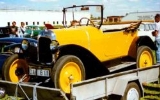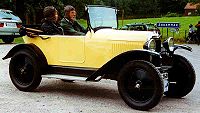
Citroën Type C
Encyclopedia



Citroën
Citroën is a major French automobile manufacturer, part of the PSA Peugeot Citroën group.Founded in 1919 by French industrialist André-Gustave Citroën , Citroën was the first mass-production car company outside the USA and pioneered the modern concept of creating a sales and services network that...
car company between 1922 and 1926 with almost 81,000 units being made. The car was originally called the Type C but was updated to the C2 in 1924 which was in turn superseded by the slightly longer C3 in 1925. The Type C was, and still is, also well known as the 5CV due to its French fiscal rating
Tax horsepower
The tax horsepower or taxable horsepower was an early system by which taxation rates for automobiles were reckoned in some European countries, such as Britain, Belgium, Germany, France, and Italy; some US states like Illinois charged license plate purchase and renewal fees for passenger...
of its engine for taxation purposes. More colloquial sobriquets, referring to the tapered rear of the little car's body, were 'cul-de-poule' (hen's bottom) and 'boat deck Citroën'.
The four cylinder engine had a capacity of 856 cc with a bore of 55 mm (2.2 inches) and stroke of 90 mm (3.5 inches) making 11 bhp. There was a single Solex carburettor and ignition was by a magneto. An electric starter was standard allowing the car to be advertised as especially suitable for lady drivers.
There were 2 types of chassis, the C (also used for the C2) and C3 varying in length, the original Type C and C2 being 2.25 metres (7.4 feet) long and the 1925 C3 2.35 metres (7.7 feet). The suspension used inverted quarter elliptic springs at the front and rear and braking was on the rear wheels, controlled by a hand lever and on the transmission by the foot brake. The maximum speed was in the order of 60 km/h (37 mph) with a fuel consumption of 5 litres per 100 kilometres (56 mpg (Imperial)).
Only open bodies were made with the original Type C, often nicknamed the "Petit Citron" (little lemon), due to it only being available in yellow at first, as one of the more popular variants. The C2 tourer was a two-seat version but the C3 was a three-seat "Trefle" (Cloverleaf) three-seat model with room for a single passenger in the rear. There were also C2 and C3 Cabriolets made.
There was also a wide range of C2 and C3 commercial models with 32,567 being built.

